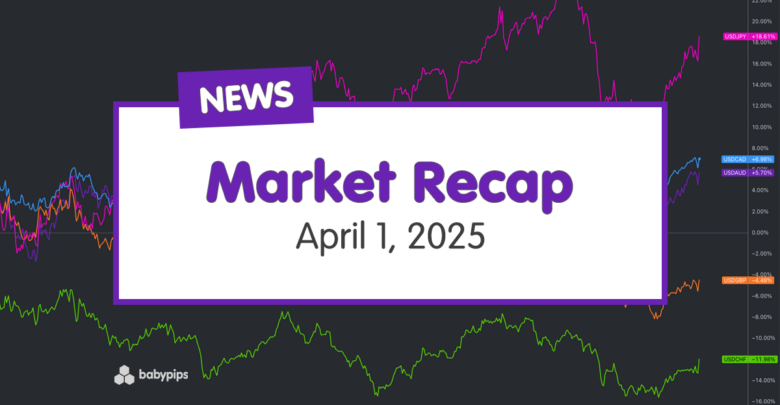The major assets were all over the charts on Tuesday as the markets braced for Trump’s “Liberation Day” tariffs on April 2.
Gold and oil prices eased from their Monday highs while U.S. bond yields and the U.S. dollar fell as tariff uncertainty kicked in.
Check out the headlines you may have missed in the last trading sessions!
Headlines:
- RBA kept rates steady at 4.10%, AUD recovered as Gov. Bullock tempered dovish RBA takeaway
- Japan Tankan manufacturing index for Q1 2025: 12 (12 forecast, 14 previous); Non-manufacturing index rose from 33 to 35 (vs. 33 expected)
- China Caixin manufacturing PMI for March: 51.2 (50.6 forecast, 50.8 previous); Factory gate prices were reduced; Job market improved “marginally”
- Japan au Jibun Bank final manufacturing PMI for March revised higher from 48.3 to 48.4; Job creation was the quickest seen so far in 2025; Output inflation softened to a five-month low
- France HCOB final manufacturing PMI for March: 48.5 (48.9 forecast; 45.8 previous)
- Germany HCOB final manufacturing PMI for March: 48.3 (48.3 forecast; 46.5 previous)
- Euro Area HCOB final manufacturing PMI for March: 48.6 (48.7 forecast; 47.6 previous)
- Euro Area CPI for March: 2.2% y/y (2.1% forecast; 2.3% previous); 0.6% m/m (0.6% forecast; 0.4% previous); Core CPI at 2.4% y/y (2.6% forecast; 2.6% previous)
- Switzerland procure.ch manufacturing PMI for March: 48.9 (50.5 forecasts; 49.6 previous)
- U.K. S&P Global final manufacturing PMI for March: 44.9 (44.6 forecast; 46.9 previous)
- S&P Global Canada manufacturing PMI for March: 46.3 vs. 47.8 previous
- U.S. S&P Global final manufacturing PMI for March: 50.2 (49.8 forecast; 52.7 previous)
- U.S. ISM manufacturing PMI for March: 49.0 (50.0 forecast; 50.3 previous); Prices rose +7.0 to 69.4; Employment fell -2.9 to 44.7
- U.S. JOLTs Job Openings for February: 7.57M (7.6M forecast; 7.74M previous); Quits fell to 3.2M vs. 3.27M previous
- FOMC non-voting member Tom Barkin said that Trump’s tariffs could raise both inflation and unemployment
- European Commission President Ursula von der Leyen hinted at hitting U.S. services exports, including those from Big Tech companies, in retaliation for Trump’s “Liberation Day” tariffs
- Canada PM Mark Carney reiterated his readiness to place “retaliatory measures” should there be additional tariffs on Canadian goods on April 2
Broad Market Price Action:

Dollar Index, Gold, S&P 500, Oil, U.S. 10-yr Yield, Bitcoin Overlay Chart by TradingView
The major assets were all over the place on Tuesday as traders positioned ahead of President Trump’s tariff announcement scheduled for April 2.
Early concerns stemmed from a Washington Post report suggesting White House aides had drafted a 20% tariff proposal on most imports, though advisers emphasized no final decision had been made. Trump later hinted he would be “very kind” with a “reciprocal” approach.
That murkiness sent 10-year Treasury yields sliding to 4.16% – the lowest since December – as investors shifted into safe havens. Stocks swung back and forth all day, caught between trade jitters and potential bargain hunting. Biotech and pharma names weighed on the indexes, but software stocks showed some relative strength. Over in Europe, markets fared better, with Germany’s DAX jumping 1.67%.
Gold pulled back marginally from record highs, and WTI oil retreated from five-week highs amid supply concerns after Trump threatened Russia with oil tariffs of 25-50% and warned Iran of “bombing” if it didn’t agree to a nuclear deal.
Bitcoin experienced significant volatility, trading between $82,600 – $85,400 before settling around $85,200. U.S. economic data disappointed with manufacturing activity contracting at 49.0 in March, though construction spending rose 0.7%, exceeding expectations.
FX Market Behavior: U.S. Dollar vs. Majors:

Overlay of USD vs. Major Currencies Chart by TradingView
The U.S. dollar was all over the place on Tuesday as traders reacted to a swirl of mixed data and policy headlines. The Greenback started weaker, likely as upbeat China Caixin manufacturing PMI (51.2) boosted risk sentiment and trimmed safe-haven flows. The downside held even after the RBA kept rates steady at 4.10%, suggesting limited policy divergence for now.
In Europe, the dollar dipped initially despite weak Euro Area manufacturing PMI (48.6), but regained ground after softer inflation data (2.2% y/y). The print likely raised the odds of an April ECB rate cut, prompting a reassessment of rate differentials in the dollar’s favor.
More action came in the U.S. session. Disappointing ISM manufacturing and JOLTs job openings increased the probability of Fed rate cuts, triggering a sharp sell-off in the dollar. This move coincided with U.S. 10-year yields sliding to 4.156%, the lowest since December, as safe-haven demand spiked amid tariff uncertainty.
Later in the session, the dollar stabilized as attention turned to Trump’s upcoming tariff announcement. Reports hinting at a narrower, targeted approach helped ease some pressure. The dollar ended mixed but generally weaker against commodity currencies.
Upcoming Potential Catalysts on the Economic Calendar:
- France government budget balance at 6:45 am GMT
- Spain unemployment change at 7:00 am GMT
- U.S. ADP non-farm employment change at 12:15 pm GMT
- U.S. factory orders at 2:00 pm GMT
- U.S. crude oil inventories at 2:30 pm GMT
- U.S. President Trump to give a speech at 8:00 pm GMT
- FOMC member Kugler to give a speech at 8:30 pm GMT
Traders can expect a relatively quiet European session calendar, with second-tier data like the French budget balance and Spanish unemployment unlikely to spark major moves unless the German bond auction surprises.
In the U.S., tariff concerns could heat up with Trump giving a speech at 8:00 pm GMT. Meanwhile, eyes will also be on the ADP employment report for clues ahead of Friday’s NFP report.
Don’t forget to check out our brand new Forex Correlation Calculator when taking any trades!
